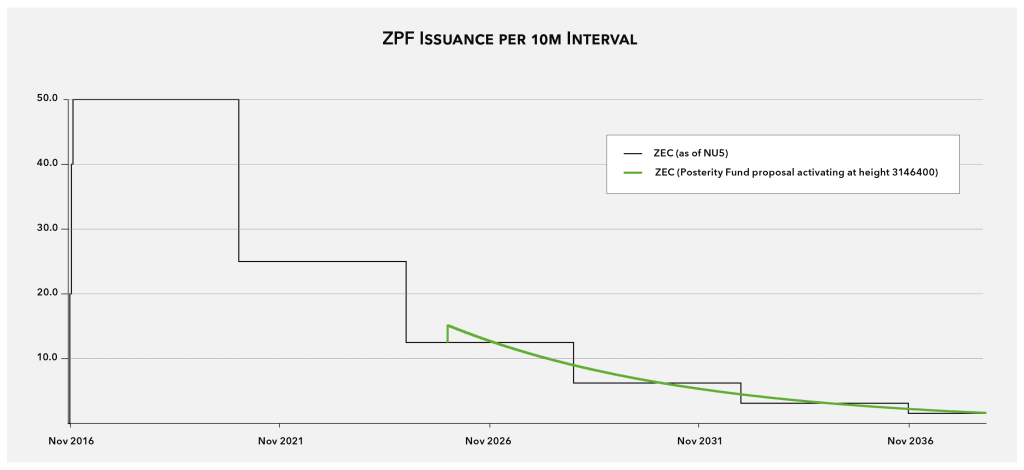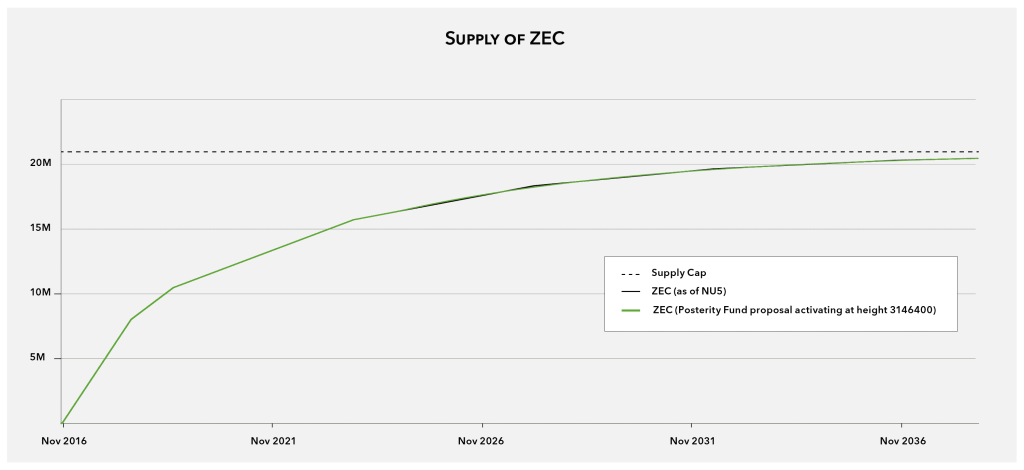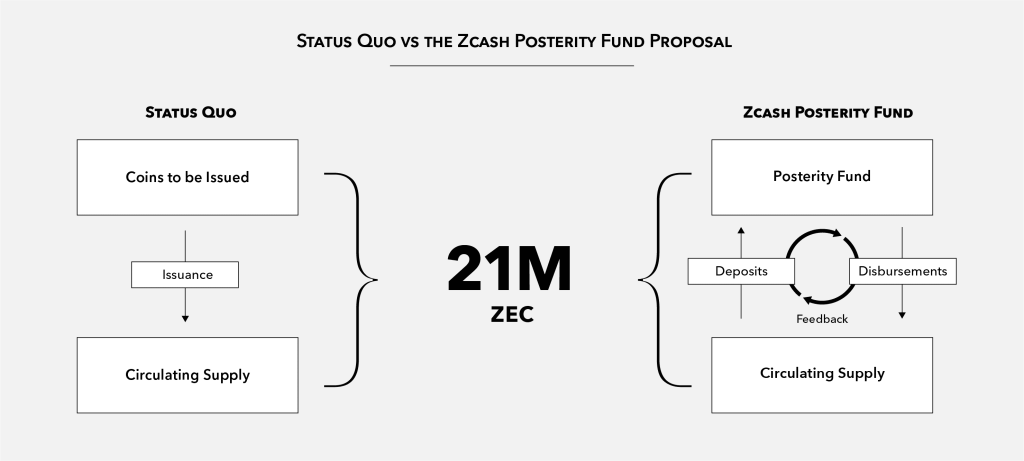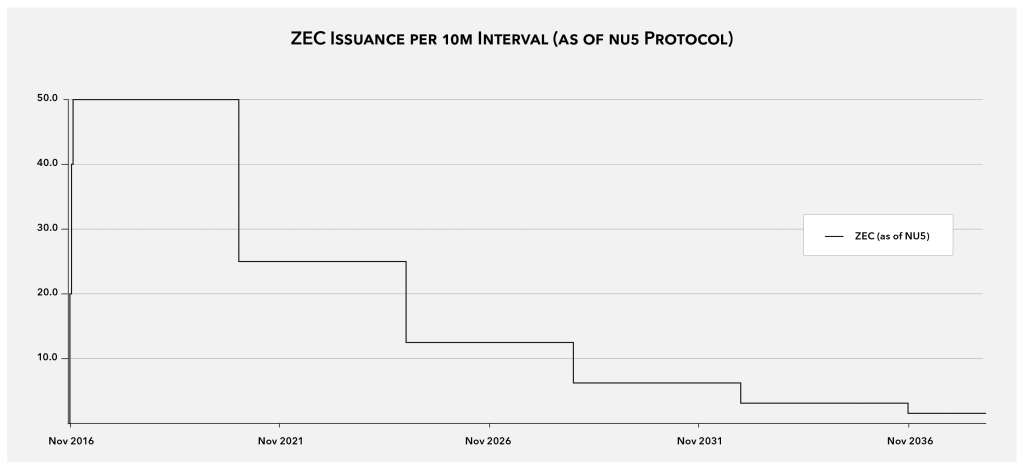
[ad_1]
As we conduct analysis into Proof-of-Stake (POS) and develop a suggestion for Zcash, an excellent key space is how the issuance schedule for brand new ZEC would work together with PoS safety. On this put up, we take a step again from PoS itself, and analyze how issuance and costs assist long-term community sustainability. We introduce a proposal, which we name the Zcash Posterity Fund (ZPF), for modifying ZEC issuance with the intention to enhance long-term monetary sustainability of the community, whereas sustaining the 21M ZEC provide cap and approximate issuance price. This proposal is unbiased from PoS or any consensus protocol suggestions and could possibly be adopted with the present PoW consensus protocol with the identical advantages and downsides. We will probably be gathering suggestions from throughout the Zcash ecosystem about this proposal.
We imagine this proposal could possibly be a helpful precursor to 3 promising strains of improvement for ZEC:
- Enhancements to transaction price mechanisms can use the Zcash Posterity Fund to enhance resilience and predictability of the community.
- A transition to PoS can depend on this proposal to make sure key properties of the provision and issuance schedule are preserved.
- New performance resembling Zcash Shielded Property can use this proposal for brand new price mechanisms which have good incentive alignment for ZEC sustainability.
As a result of all three of those nascent enhancements are underway, we need to float this proposal now to see if it could profit all three efforts.
Moreover, this proposal introduces a solution to direct funds in the direction of sustaining the community into the long run, so adopting the proposal earlier permits that funding mechanism to start accruing worth earlier.
The core innovation of Bitcoin which all cryptocurrency inherits is that the community funds itself. In Bitcoin, Ethereum, and lots of public crypto networks, the built-in funding is paid out to dam producers. In Zcash, this funding is break up between block producers and the Zcash Improvement Fund, which contributes to training, expertise improvement, and different actions that assist and improve ZEC.
Typically, funding to assist a community can both come from throughout the protocol itself, for instance in mining rewards, or from different sources, resembling when a company has raised capital elsewhere and funds improvement work on the protocol or merchandise.
Exterior funding is necessary and may have a big influence. Nevertheless, there’s no assure when or the place these sources will seem, that these funding sources have incentive alignment with ZEC holders, or that they may stay as reliable sources of funding over an extended interval. For all of those causes, we imagine it’s necessary for ZEC customers to deal with sustaining or enhancing the intrinsic sustainable funding mechanisms within the protocol itself.
This put up and the Posterity Fund proposal deal with the sources and quantities of community funding and are agnostic as to the recipients, so they’re relevant to the present mining & Dev Fund construction of ZIP-1014, or future modifications to infrastructure & improvement funding, consensus mechanisms, or different modifications to funding recipients.
We suggest a change to the Zcash issuance system we name the Zcash Posterity Fund to assist scale back uncertainty about the long run sustainability of Zcash whereas sustaining the important thing properties we imagine most ZEC customers prioritize. The proposal maintains these properties (together with their advantages and downsides):
- The 21M ZEC provide cap,
- A disbursement price that constantly halves each 4 years,
- A non-discretionary issuance price.
In the meantime, this proposal would change these excessive degree options from the present Zcash design:
- The halving epochs would get replaced by a easily declining disbursement curve,
- Charges which deposit into this mechanism can be distributed over time in block rewards.
Zcash Posterity Fund definition
The precise excessive degree definition of the Zcash Posterity Fund proposal is as follows:
If the proposal is activated, a brand new Fund can be solely managed by the protocol. (There are not any non-public keys, wallets, people, or organizations controlling this protocol-managed Fund.)
The preliminary stability of the Fund when created is the same as the variety of not-yet-issued cash, or equivalently 21M ZEC minus the present excellent provide.
Ranging from the block of activation, the present block reward guidelines not apply, and as an alternative block rewards come from ZPF Disbursements.
The proposal doesn’t outline the recipients of disbursements, which ought to stay unchanged if this proposal is accepted. In the meantime, the proposal does limit the quantity of disbursement:
- Disbursements could also be not more than a hard and fast share, X%, of the Fund’s present stability in a given block.
- The parameter X% is calculated from the block goal time in order that with none incoming Fund deposits, the stability of the Fund reduces to half over a 4 12 months interval.
- If future modifications to consensus guidelines alter the block goal time, or different facets of transaction finalization timing, these modifications should replace this X% parameter to suit the “4 12 months half life” rule to the very best sensible approximation for that new protocol.
- Future consensus modifications shouldn’t alter the stability of the Fund aside from by instituting new deposits from the extant provide.
- Future consensus modifications shouldn’t enhance the disbursement price X% past the “4 12 months half life” rule.
The ultimate piece of the ZPF proposal is that it now turns into potential to switch Funds from the circulating provide again into the Fund by way of Deposits. Future protocol-enforced price mechanisms might require charges to do that. This base proposal just isn’t particular to any explicit deposit mechanisms.
Visualizing modifications to issuance & provide schedules
If this alteration had been adopted and there have been no deposits, the disbursements would alter issuance away from halvings right into a easy curve. We will visually evaluate present issuance to disbursements with out deposits for a hypothetical activation peak:

This makes use of a hypothetical activation peak after the second halving.
If there are vital deposits into the Fund, the slope of the disbursement curve can be elevated above the road proven. In any interval with out deposits, the curve would proceed to have the identical price of exponential decay with a unfavourable slope.
The influence on the general provide schedule within the absence of deposits is barely seen at a very long time scale:

This chart makes use of the identical hypothetical activation peak because the earlier chart.
Within the presence of deposits, the provision will at all times be equal or lower than the road above. With enough deposits the provision development price may even change into unfavourable throughout that interval.
The Posterity Fund and sustainability
The important aspect of the Posterity Fund is to allow deposits from the circulating provide, which permits a suggestions loop from present utilization to future funding:

Each the established order and this proposal have a capped provide of 21M. We will consider the proposal as introducing a single new aspect, deposits, which allow a suggestions loop between the circulating provide and future funding.
This doesn’t “resolve” long run sustainability by itself, however it supplies a framework that focuses the issue of sustainability on discovering enough sources of deposits to take care of the community. If over longer time scales of years, the speed of deposits is the same as or bigger than payouts, the system can run indefinitely. In the meantime, if over shorter time spans of months or much less, the deposits are beneath the payout price, the protocol can climate that interval for fairly a while.
Sustainability of the established order
Up to now the Zcash community funds itself utilizing the Bitcoin design. New cash are issued on a schedule that approaches a restrict of 21M models over time:

The issuance over time follows the Bitcoin halving schedule design:

Challenges with the established order
As newly issued cash are circulated to customers, the quantity of future issuance is depleted to take care of the 21M ZEC cap. As this quantity dwindles, community funding should come from different sources and the one different present supply is transaction charges paid on to miners.
Transaction charges are depending on transaction demand, which is extremely unpredictable. We imagine transaction demand can typically change into dominated by exterior occasions resulting in spikes or troughs of utilization. This can be ameliorated when there’s a massive diffuse community of customers, however even on the scale of worldwide economies there are extrinsic occasions that trigger fee demand to fluctuate in a extremely correlated, but unpredictable, vogue. Anchoring the operation of the community to the unpredictability of transaction demand makes it troublesome to foretell how resilient the community may be, which interferes with long run dedicated planning. That is necessary for customers and particularly for the community infrastructure operators themselves, who have to resolve methods to make investments capital into infrastructure enhancements.
An extra wrinkle for Proof-of-Work and doubtlessly different non-finalizing protocols, generally known as “price sniping”, is that with direct charges as the one income supply, there’s a miner incentive to rollback blocks with massive price transactions to place these charges into their very own block. This might derail protected progress of the chain.2
The Zcash Posterity Fund proposal addresses this uncertainty by smoothing out disbursements over time. Whereas it doesn’t assure that deposits will probably be sufficient to take care of or develop the Fund stability to maintain the community indefinitely, it removes quick time period uncertainty concerning the price of disbursements. This permits customers, infrastructure operators, and improvement fund recipients to decide to long term plans which makes the community itself extra resilient.
These sorts of considerations, and this sort of proposal, are additionally current in Bitcoin and have been mentioned all through its historical past. The Bitcoin OpTech e-newsletter summarizes a latest dialogue about these points amongst Bitcoin builders.
Sustainability of deposits
The Zcash Posterity Fund design reduces community sustainability to a query of enough deposits. If deposits over a while interval are better than disbursements, the community is “paying it ahead” and supporting future operation and improvement. If these deposits are smaller than the disbursements, the community is depleting its assets to proceed its present operation and improvement. So with this framework, the important thing focus for community sustainability is discovering a design and utilization that contributes enough deposits over time on common.
Deposits can come from numerous charges for utilizing the community. A simple instance can be to require a portion of present transaction charges to be deposited into the Fund with the rest going to the miner.
If this proposal had been adopted, the neighborhood might observe the pattern of whether or not or not deposits over an extended sufficient time window outpace disbursements. If they’re beneath disbursements and there’s concern concerning the Fund stability dwindling too low3, the neighborhood would have some period of time to seek out sources of bigger deposits.
Discovering extra deposits may come from a wide range of methods. We observe that for any set of options, performance, and use instances, growing the community capability would decrease transaction charges on common, which might entice extra utilization of the prevailing use instances. As long as the prevailing use instances have some traction and a few price of natural development restricted solely by value, growing community scalability might typically be an excellent possibility. Other than that common technique, growing utilization by enhancing present merchandise and use instances, creating performance for brand new use instances, and advertising to potential new customers of present use instances might all be good methods.
Now that we’ve shared this proposal, our intent is to assemble neighborhood suggestions and carry out market analysis on this proposal. If the proposal appears to have large assist, we might construct on that understanding in a couple of methods:
- We’d tailor our Proof-of-Stake analysis with an assumption that the Zcash Posterity Fund would constrain the design of issuance. With out apparent assist for the Posterity Fund proposal, methods to adapt ZEC issuance to PoS protocols stays a extra open ended query.
- We’d start refining this high-level proposal right into a concrete Zcash Enchancment Proposal.
- We might produce a follow-on proposal for altering transaction charges to enhance resilience, UX, and privateness, just like this proposal (Zcash ticket #3473).
- We’d encourage new protocol proposals that influence ZEC tokenomics to think about integrating some sort of deposit mechanism. The distinguished instance is Zcash Shielded Property.
Do you’ve suggestions or questions on this proposal? Tell us by discussing on this discussion board put up devoted to the Zcash Posterity Fund proposal.
- The entire issuance/disbursement and provide charts had been generated utilizing this code.
- This concern was first expressed to me by Greg Maxwell at Scaling Bitcoin in Montreal. This concern could also be particular to any dynamically out there protocol, and could also be addressed by finalizing protocols. It could even be addressed by completely different price mechanisms as this text proposes.
- When the fund stability is massive, it’s in all probability acceptable to permit disbursements to outpace deposits: we will consider this as utilizing a portion of the max provide to subsidize a decrease value of utilization (e.g. decrease transaction charges) for the present customers to stimulate adoption and development.
[ad_2]